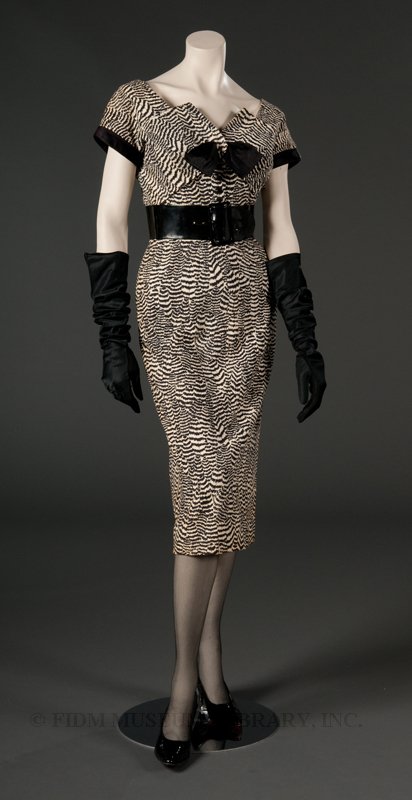Jacques Fath, Spring/Summer 1953

"St. Charles" afternoon dress
Jacques Fath
Spring/Summer 1953
Museum Purchase
2010.5.26
Jacques Fath (1912-1954) was an impish designer who imbued his clothes with a sense of fun and glamour. Vogue praised his "unexpected mix of casual style and luxurious material."1 Such contrasts are seen in this satin-trimmed, formal afternoon dress titled "St. Charles," which is tailored to the exacting standards of haute couture. Fath's use of informal cotton piqué for this dress instead of the expected wool broadcloth or heavyweight silk did not diminish its hefty price of $595. The printed feather motif is a humorous touch, setting Fath apart from other mid-century couturiers. His unique blend of formality with practicality was particularly appreciated in the United States; this pencil-skirted creation was deemed "one of the best dresses in the Fath collection...To wear—constantly from now on."2
Because of Fath's untimely death at age 42, his role in the world of post-war haute couture is sometimes overlooked. During his lifetime, however, Fath was considered a leading Parisian couturier. Fath established his first small salon in 1937, gradually building a following. The designer's early years were lean; he often used a client's initial deposit on a dress to purchase the fabric required to make it. Fath joined the French military in 1939, but was demobilized in 1940 or 1941. Upon his release, Fath and his wife Genevieve (former secretary to Coco Chanel) reopened Fath's eponymous house. Like many Parisian couturiers, Fath worked throughout World War II, producing haute couture for Parisian women. His wartime clientele were reportedly youthful and elegant, "with no need to cling to the traditions of the past."3
After the war, Fath moved quickly to establish an American clientele. In 1948, Fath and his wife toured the United States. Publicity for the tour included details of Genevieve’s extensive Jacques Fath travel wardrobe. Consisting of 35 ensembles and appropriate accessories, it was persuasive proof of Fath's talent. During this visit, Fath cemented his business relationship with US clothing manufacturer Joseph Halpert. Under the terms of their agreement, Fath began designing two annual collections, about 40 designs total, for mass-market production and distribution throughout the United States.
At home, Fath was a noted host, throwing lavish parties at his home outside of Paris. With 40 rooms, Fath's roomy chateau accommodated both intimate cocktail parties and large formal balls. Jacques and Genevieve were frequent hosts, entertaining several times each month. Guest lists were a social and economic jumble, including cafe society, celebrities, and aristocrats. Accordingly, their annual champagne bill was astronomical—$3,000 in 1949!4
By the early 1950s, Fath's reputation was secure. During the years 1950-53, Fath opened a Paris boutique, introduced two new perfumes, and launched Jacques Fath Université, a high-end ready-to-wear label. He also continued to produce haute couture. If not for his death from leukemia in 1954, Fath's renown would have continued on its positive trajectory. After her husband's death, Genevieve assumed leadership of the house, continuing operations until 1957.
1 Savignon, Jéromine. Jacques Fath (New York: Assouline Publishing, 2008), 18.
2 Vogue (May 15, 1953), 88.
3 Veillon, Dominique. Fashion Under the Occupation (Oxford: Berg, 2002), 119.
4 Coughlan, Robert. "Designer for Americans." Life (Oct. 17, 1949), 82.